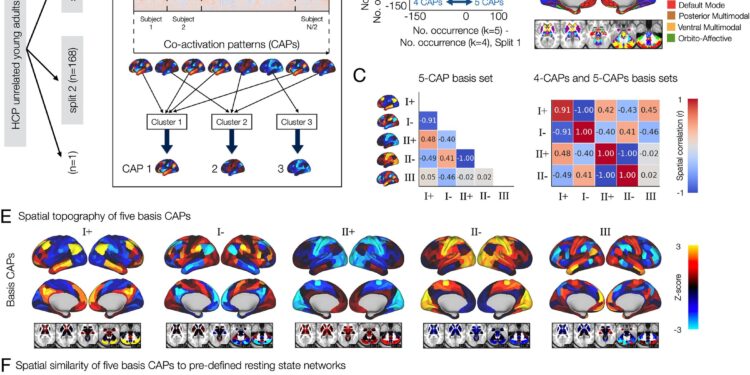A reproducible set of CAPs in whole-brain rs-fMRI involves recurrent mixed representations of canonical resting-state networks. Credit: PLOS Biology (2024). DOI: 10.1371/journal.pbio.3002808
One of the main challenges in linking brain activity to behavior is that brain activity, as measured by functional magnetic resonance imaging (fMRI), for example, is extremely complex. This complexity can make it difficult to find recurring patterns of activity across different people or within the same individual.
In a new study, Yale researchers were able to take fMRI data, reduce its complexity, and in doing so uncover stable patterns of activity shared by more than 300 different people. The findings, the researchers say, represent a promising advance in the discovery of biomarkers for psychiatric disorders.
The study was published September 24 in the journal PLOS Biology.
“Human brain activity is very complex and therefore can be unreliable, especially when aiming for reproducibility,” said Kangjoo Lee, lead author of the study and a research associate in the Department of Psychiatry at Yale School of Medicine. “In this study, we wanted to identify features of brain activity that were related to features of human behavior and were also consistent across different people.”
To do this, the researchers used fMRI data from 337 healthy young adults, each of whom underwent four 15-minute fMRI scans.
“These images, taken at rest, are actually snapshots of brain activity,” Lee says. “Over time, we were able to observe instantaneous changes in brain activity.”
Each snapshot represented activity occurring across the entire brain at a single moment, which included many different brain networks engaged in many different processes, contributing to the complexity of the data.
To reveal common patterns in the data, the researchers applied an approach called data dimensional reduction, which Lee says essentially takes complex, high-dimensional data, such as brain activity, and reduces it to a lower-dimensional space. The idea is similar to representing the complex pattern of a dance sequence through a small number of basic movements.
After reducing the complexity of the data, the researchers discovered three common patterns of brain activity that were “highly consistent across all participants and within themselves,” Lee said.
Additionally, while these trends were observed across participants, differences were also observed between individuals. For example, the researchers observed differences in which of the three states individuals spent the most time in, how long they stayed in certain states, and which states individuals transitioned between.
The results suggest that these types of models could reveal information about something common to different people (such as a behavior), as well as individual differences in those behaviors or how they change over time.
Researchers are now considering how this approach could be applied to psychiatric disorders.
“We studied healthy adults here, but if we did a similar analysis in a clinical population, we might find recurring brain patterns that are shared by that population but not by healthy individuals,” said study co-senior author John Murray, a former professor of psychiatry and physics at Yale, now a professor at Dartmouth College. “Therefore, these common patterns could represent useful biomarkers of psychiatric illness in clinical settings.”
The current study supports this idea. The researchers found that the patterns in which people spent more time and the patterns they switched to were associated with cognitive function, emotion regulation, and alcohol and substance use.
“Finding recurring brain patterns in clinical populations could tell us more about the neural activity associated with specific symptoms and how it differs across individuals,” Lee said.
More information:
Kangjoo Lee et al, Human brain state dynamics are highly reproducible and associated with neuronal and behavioral characteristics, PLOS Biology (2024). DOI: 10.1371/journal.pbio.3002808
Provided by Yale University
Quote: Biomarkers for psychiatric illnesses? Study brings researchers one step closer to goal (2024, September 25) retrieved September 25, 2024 from
This document is subject to copyright. Apart from any fair dealing for the purpose of private study or research, no part may be reproduced without written permission. The content is provided for informational purposes only.



